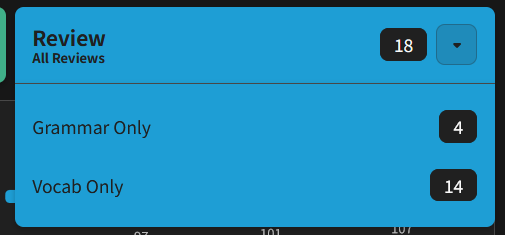Answer
この後私でかけますんで。This is a mix between polite speech and casual speech. The んで is ので ‘because’. She is saying ‘Since I’m going out after this, I’ll keep an eye out for someone like that then’.

この後私でかけますんで。This is a mix between polite speech and casual speech. The んで is ので ‘because’. She is saying ‘Since I’m going out after this, I’ll keep an eye out for someone like that then’.
Just finished up my reading for today! Today was a bit easier than yesterday hehe.
One note: The 南下 in the vocab deck is, I’m pretty sure, not the なんか that shows up in this section
Pg. 16: こちらに引っ越してこられた方ですか
I’m figuring this means something like “Are you the person that moved here?” but why the passive form of くる?I’m struggling to figure out what affect that would have on the nuance.
This usage of the passive form as honorific is probably what you were looking for: using passive form as honorific - Grammar - Kanshudo
It’s also briefly mentioned in this Bunpro grammar point (Verb[れる・られる] (JLPT N4) | Bunpro, first red box), but that would be easy to overlook. Not sure if that gets brought up again during later grammar points.
Fixed! 
A bunch of additional fixes should go through tomorrow. We will probably also be adding grammar to the decks.
Page 16:
What is the significance of the 分 in “そのダンボ-ル ゴミに出す分ですか?”
Is this some other honorific thing, or does it carry additional meaning (maybe like ながら or ほしい)?
Page 18:
Could the “ずいぶんね” be translated as “That’s a bit harsh/extreme”?
Page 16: The 分 here just means ‘part’, it’s like ‘are those boxes the part/portion you’re throwing out?’
Page 18: Yep, that’s correct. Or ‘Wow tell me how you really feel (sarcastically)’.
Ah no wonder I couldn’t find any special grammar related to 分 lol
I’ve gotta say, I love the Dad’s description of Yotsuba today:
“If you see a kid who makes you think ‘what a wierdo’, that’s probably her”
Or at least, that was my interpretation of it.
Those videos are superhelpfull, learned a lot of small nuances. Thanks for sharing.
Finished with my daily readings too. I have a questions regarding the vocab deck…
I never did any vocabs in Bunpro, only ever used it for the grammar section. Is it somehow possible to split the review-stack in two separate stacks? One for grammar and one for vocabs? I really don’t want to mix these up.
I’m unsure if this is what you want, but you can click the drop down arrow beside Review to individually review vocab and grammar:

In addition the bars for both your forecast and activity use two distinct colours for vocab vs grammar to distinguish the two.
Also I’ve finished my daily 5. See y’all tomorrow.
Yes, that’s exactly what I want but i do not have that? Do I have to enable that somewhere?

(Sorry, for going slightly off topic…)
Edit: Ah! I really had to activate it!
I finally finished my today reading, even if I am a bit late. I have received the real book, and it is much better to read than the online sample version.
I only have some questions about page 17 :
I had trouble to understand the “しっかり”, in this context. I guessed it meaned something like serious or dependable but really not sure.
What is this form: “消えちゃった” in this sentence ?
Thanks
I think you just need to go to your settings page, select “Reviews” on the left side bar, scroll down to “General” and turn on “Split Reviews”.
And Neon, thats a very nice haul.
1.) In this case, I believe しっかり just means hard working/reliable/doing something properly (I feel like it’s hard to explain rather than understand lol)
Also the てん is shortened form of ているの iirc too.
2.) As for “消えちゃった”, its the verb ‘消える’ to disappear +
the auxiliary verb ちゃう which is just a slang/colloquial version of the てしまう grammar point. じゃう can also be seen for verbs that te form end in んで + still means the same thing
An example being 死ぬ to 死んで to 死んじゃう
There’s a grammar point for てん in the 関西弁 deck here:
I’m gonna add this to our list of grammar to put on the site. I think it’s common enough that we should have it in general (not just the kansai version)
Phew, finished up late today!
Some guesses / notes / deck QA:
“You’ve got your sh*t together, huh? When I was in high school… actually even now I didn’t have it together (like you do)…
I’m fairly sure that this is the て-form of しっかりする, like “to take a firm grasp on stuff”, but I can’t quite say why he’d use that form and not the plain form.
Lastly, the vocab card for 後 supplies “ご” furigana instead of “あと”
I really struggled with
[quote=“semanticman, post:122, topic:85890”]
しっかり
[/quote] too! Thanks for your insights. I felt like each panel goes between easy and insane, reminds of dark souls a little lol